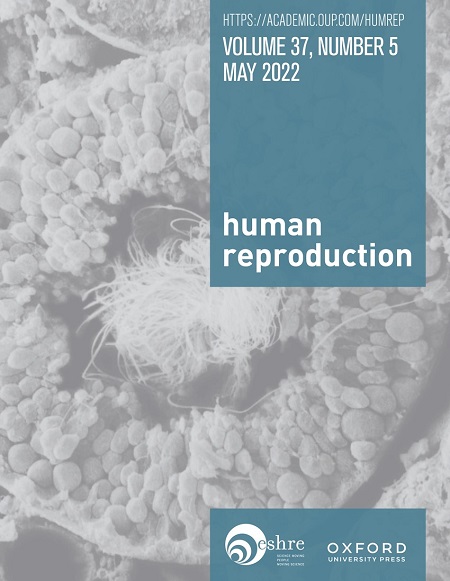Impact of female age on concentrations of reproductive hormones and oocyte-specific growth factors in follicular fluid from human small antral follicles
IF 6
1区 医学
Q1 OBSTETRICS & GYNECOLOGY
引用次数: 0
Abstract
STUDY QUESTION Does maternal age impact hormonal secretions from granulosa cells, theca cells, and the oocyte in human small antral follicles? SUMMARY ANSWER Major hormones secreted by granulosa and theca cells, as well as the oocyte-specific TGF-β members—GDF9, BMP15, and the GDF9/BMP15 heterodimer cumulin—maintain a consistent concentration within the follicular fluid of human small antral follicles, regardless of maternal age. WHAT IS KNOWN ALREADY It is well established that female fertility declines with increasing age. However, it is not known whether this decline is exclusively due to a reduction in oocyte quality and quantity or also involves a decline in the hormone-secreting capabilities of granulosa cells, theca cells, and the oocyte itself. STUDY DESIGN, SIZE, DURATION This is a retrospective study of follicular fluid obtained from human small antral follicles collected in connection with cryopreservation of ovarian tissue at the Laboratory of Reproductive Biology, University Hospital Copenhagen, Rigshospitalet, Denmark, between 2010 and 2020 as part of the hospital’s fertility preservation program. PARTICIPANTS/MATERIALS, SETTING, METHODS Follicular fluid samples from human small antral follicles measuring 3–13 mm in diameter from macroscopically normal ovaries of 381 patients aged 5–43 years were included in the study, provided that at least one of the following parameters was measured: AMH, Inhibin A, Inhibin B, oestradiol (E2), progesterone (P4), androstenedione, testosterone, and/or the oocyte-specific TGF-β members GDF9, BMP15, or cumulin. MAIN RESULTS AND THE ROLE OF CHANCE In a linear regression analysis adjusted for follicular volume, female age did not predict the follicular fluid concentrations of AMH, Inhibin B, Inhibin A, E2, androstenedione, testosterone, GDF9, BMP15, or cumulin. Although a significant association was observed between female age and follicular fluid P4 levels, the predictive value of age was poor, accounting for at most 5% of the variation in P4. LIMITATIONS, REASONS FOR CAUTION Hormonal levels may vary with the degree of atresia in each follicle; however, the health status of the small antral follicles in this study was not characterized. Additionally, we cannot exclude possible age-related differences in human follicles larger than 10 mm, as very few of these were included. Furthermore, we did not include women above the age of 43, despite the potential for more pronounced age-related effects in these patients. WIDER IMPLICATIONS OF THE FINDINGS Our results support the idea that the age-related decline in female fertility is primarily due to a reduction in oocyte quality and quantity, but further research is needed to confirm this. STUDY FUNDING/COMPETING INTEREST(S) No specific funding was obtained, and the authors have no conflicts of interest to declare in relation to this work. TRIAL REGISTRATION NUMBER N/A.女性年龄对人小窦卵泡卵泡液中生殖激素和卵母细胞特异性生长因子浓度的影响
研究问题:产妇年龄是否影响人小窦卵泡颗粒细胞、卵泡细胞和卵母细胞的激素分泌?由颗粒细胞和卵泡细胞分泌的主要激素,以及卵母细胞特异性TGF-β成员——GDF9、BMP15和GDF9/BMP15异源二聚体——在人小窦卵泡的卵泡液中保持一致的浓度,而与母亲年龄无关。众所周知,女性的生育能力随着年龄的增长而下降。然而,尚不清楚这种下降是否完全是由于卵母细胞质量和数量的减少,还是也涉及颗粒细胞、卵泡细胞和卵母细胞本身分泌激素能力的下降。研究设计、大小、持续时间:这是一项回顾性研究,从2010年至2020年丹麦哥本哈根大学医院生殖生物学实验室收集的与卵巢组织冷冻保存有关的人类小腔卵泡中获得的卵泡液,作为医院生育保存计划的一部分。研究对象/材料、环境、方法从381例5-43岁患者的宏观正常卵巢中采集直径3 - 13mm的人小腔卵泡的卵泡液样本纳入研究,前提是至少测量以下参数之一:AMH、抑制素A、抑制素B、雌二醇(E2)、黄体酮(P4)、雄烯二酮、睾酮和/或卵母细胞特异性TGF-β成员GDF9、BMP15或cumulin。经卵泡体积调整后的线性回归分析显示,女性年龄不能预测卵泡液中AMH、抑制素B、抑制素a、E2、雄烯二酮、睾酮、GDF9、BMP15或积累素的浓度。虽然观察到女性年龄与卵泡液P4水平之间存在显著关联,但年龄的预测价值很差,最多占P4变化的5%。限制,谨慎的原因激素水平可能随每个卵泡的闭锁程度而变化;然而,本研究中小窦卵泡的健康状况未被描述。此外,我们不能排除大于10毫米的人类卵泡中可能存在的年龄相关差异,因为这些差异很少被包括在内。此外,我们没有包括43岁以上的女性,尽管这些患者可能存在更明显的年龄相关效应。我们的研究结果支持这样的观点,即女性生育能力与年龄相关的下降主要是由于卵母细胞质量和数量的减少,但需要进一步的研究来证实这一点。研究资金/竞争利益(S)没有获得特定的资金,作者没有与本工作相关的利益冲突需要申报。试验注册号n / a。
本文章由计算机程序翻译,如有差异,请以英文原文为准。
求助全文
约1分钟内获得全文
求助全文
来源期刊

Human reproduction
医学-妇产科学
CiteScore
10.90
自引率
6.60%
发文量
1369
审稿时长
1 months
期刊介绍:
Human Reproduction features full-length, peer-reviewed papers reporting original research, concise clinical case reports, as well as opinions and debates on topical issues.
Papers published cover the clinical science and medical aspects of reproductive physiology, pathology and endocrinology; including andrology, gonad function, gametogenesis, fertilization, embryo development, implantation, early pregnancy, genetics, genetic diagnosis, oncology, infectious disease, surgery, contraception, infertility treatment, psychology, ethics and social issues.
 求助内容:
求助内容: 应助结果提醒方式:
应助结果提醒方式:


